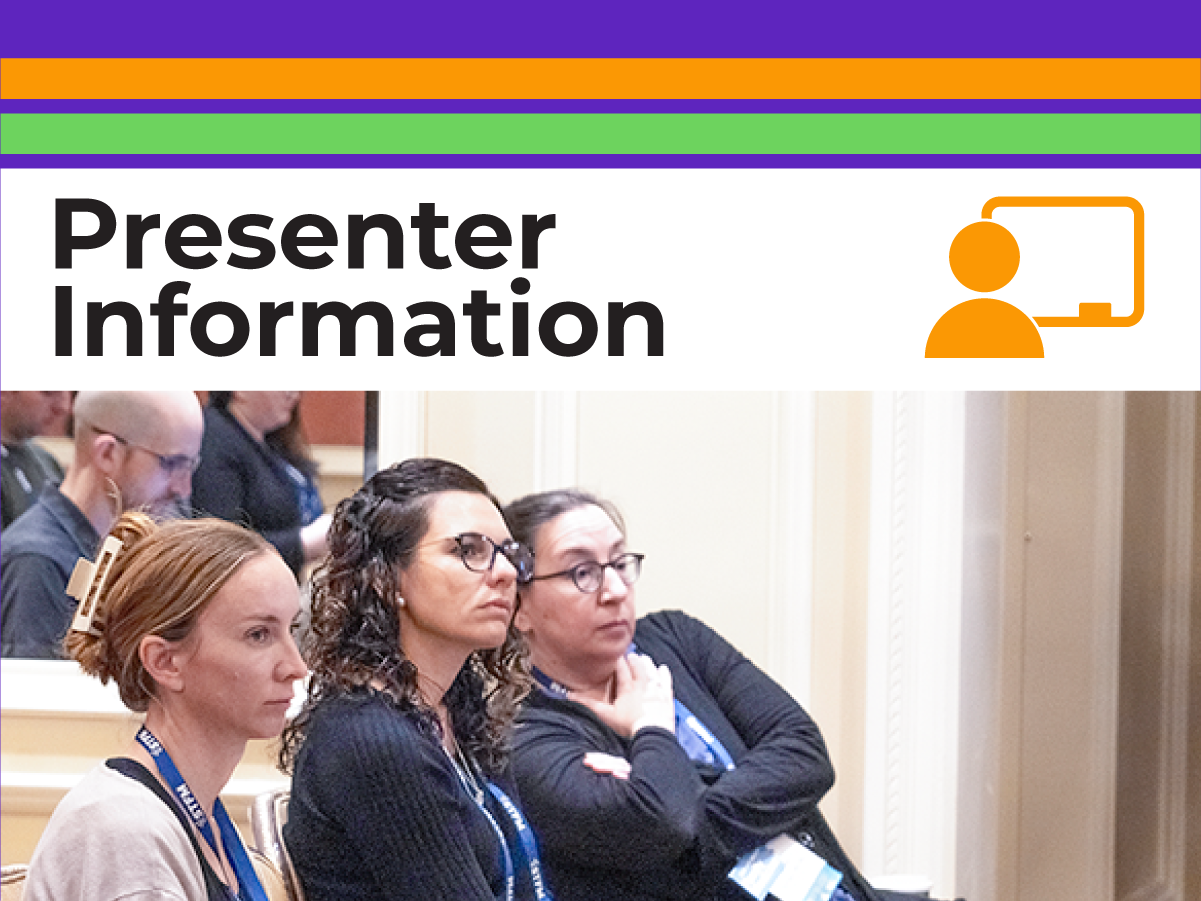Helpful Links for Presenters
All presenters must register for the conference and pay the registration fee. Presenters please download and prepare your presentation using this template:
Session Formats: Projects, Lectures, Seminars, Panels, Workshops, and Roundtable Discussions
Completed Scholarly Project
Purpose: A 13-minute presentation for presenters to briefly describe implementation and outcomes of a completed innovative educational, administrative, career development, or clinical program/project. Active audience engagement is required but limited to question and answer format.
Time: 13 minutes; 10 minutes for presentation, 3 minutes for discussion (multiple presentations grouped by topic and presented consecutively in each session)
Completed Research Project
Purpose: These sessions focus on research submissions that critically evaluate and test completed interventions in education, process of care, patient-oriented outcomes, and quality of care. Submissions must include purpose, methods, results, and conclusions.
Time: 13 minutes; 10 minutes for presentation, 3 minutes for discussion (multiple presentations grouped by topic and presented consecutively in each session)
Distinguished Paper Time: 20 minutes (15 minutes for presentation and 5 minutes for questions and discussions)
Lecture Discussion
Purpose: 30-minute session focusing on dissemination and discussion of an innovative topic related to education, administration, research, career development, or clinical practice improvement.
Required elements
- Reportable outcomes for dissemination
- Submission describes use of interactive teaching methods to be applied in the session
- Examples include: outcomes of a curricular innovation or clinical project that improved learner knowledge or practice outcomes, or an intervention that created an opportunity to meet educational needs or well-being.
Note: Projects still in progress at the time of submission (not at the time of presentation) are most appropriate for the Developing Scholarly Project Poster category. New ideas can be submitted in the Scholarly Roundtable category.
Time: 30 minutes for discussion
Seminar
Purpose: An interactive session focusing on dissemination and discussion of an innovative educational, administrative, research, career development, or clinical topic. Submission must demonstrate plan for active audience engagement.
Time: 60 minutes
Panel Discussion
Purpose: A moderated, interactive session that brings together 3-5 panelists to engage participants in discussion about an innovative or provocative topic in family medicine education. The panelists must demonstrate their content expertise in the submission and ideally, represent multiple institutions. There are limited slots for this session format.
Time: 60 minutes
Workshop
Purpose: A participatory, task-oriented, small group educational experience directed toward the acquisition, demonstration, construction, and/or synthesis of specific knowledge, skills, and /or attitudes. There are limited slots for this session format.
Time: 90 minutes
Scholarly Topic Roundtable Discussions
Purpose: Small group, interactive opportunity for 10 participants to share ideas, experiences, or projects pertinent to family medicine education, clinical care, research, or management. Presenters will briefly introduce their topic and then facilitate interaction between the participants to enhance knowledge and generate ideas. Occurs concurrently with other discussions during a 60-minute breakfast in the general session ballroom.
Time: 50 minutes (including breakfast)
Preconference Workshop
Purpose: Interactive, skill-building session that occurs on the day before the conference begins and requires more time than the other conference formats allow. Space is very limited.
NOTE: If your workshop will be sponsored by an outside (non-STFM) group, organization, or other funder, the sponsor information will be required on the submission form.
Time: 4–8 hours
Session Formats: Poster Presentations
Completed Scholarly Project Poster
Purpose: An opportunity to view and discuss implementation and results of a completed innovative educational or curricular project pertinent to family medicine.
Time: 1 hour staffing your poster during dedicated time
Completed Research Poster
Purpose: An opportunity to view quality of care studies and discuss investigators’ completed original research.
Time: 1 hour staffing your poster during dedicated time
Faculty Works-in-Progress Poster
Purpose: An opportunity for participants to view and discuss an in progress innovative educational or curricular project during a 60-minute poster session. There should be a clear plan in place for assessment while the project evaluation is still in progress. Preliminary or final results of the planned assessment should be completed prior to presentation at the conference.
Time: 1 hour staffing your poster during dedicated time
Fellow, Resident, Student Research Completed or Works-in-Progress Posters
Purpose: An opportunity to illustrate research projects currently complete or in progress by clinical or academic family medicine fellows, residents, and students.
Time: 1 hour staffing your poster during dedicated time
Behavioral Science/Family Systems Educator Fellows’ Poster
Purpose: An opportunity to view fellows' year-long projects and discuss their ongoing results and outcomes.
Time: 1 hour staffing your poster during dedicated time
Emerging Leaders Fellows’ Poster
Purpose: An opportunity to view fellow’s year-long project and discuss their ongoing results and outcomes.
Time: 1 hour staffing your poster during dedicated time
Questions?
For general questions about presentations, contact Kim Sevedge at (800) 274-7928 or the email link below.
EMAIL QUESTIONS
